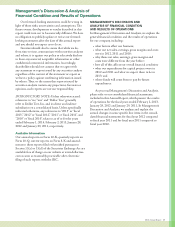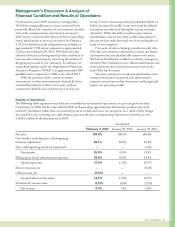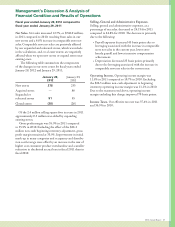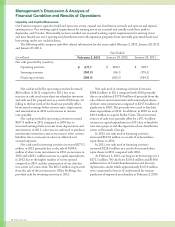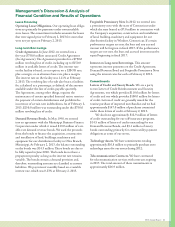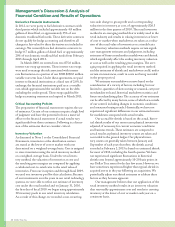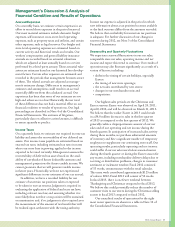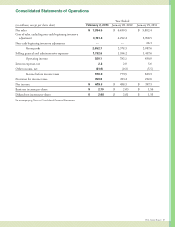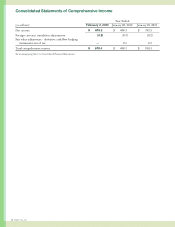Dollar Tree 2012 Annual Report Download - page 25
Download and view the complete annual report
Please find page 25 of the 2012 Dollar Tree annual report below. You can navigate through the pages in the report by either clicking on the pages listed below, or by using the keyword search tool below to find specific information within the annual report.
Management’s Discussion & Analysis of
Financial Condition and Results of Operations
Incometaxexpenseisadjustedintheperiodinwhich
new information about a tax position becomes available
orthenaloutcomediersfromtheamountsrecorded.
Webelievethatourliabilityforuncertaintaxpositions
is adequate. For further discussion of our changes in
reservesduring2012,seeNote3oftheConsolidated
Financial Statements.
Seasonality and Quarterly Fluctuations
Weexperienceseasonaluctuationsinournetsales,
comparable store net sales, operating income and net
income and expect this trend to continue. Our results of
operationsmayalsouctuatesignicantlyasaresultofa
variety of factors, including:
•shiftsinthetimingofcertainholidays,especially
Easter;
•thetimingofnewstoreopenings;
•thenetsalescontributedbynewstores;
•changesinourmerchandisemix;and
•competition.
Our highest sales periods are the Christmas and
Easterseasons.EasterwasobservedonApril24,2011,
April8,2012,andwillbeobservedonMarch31,2013.
WebelievethattheearlierEasterin2013couldresult
ina$4.0milliondecreaseinsalesintherstquarter
of2013ascomparedtotherstquarterof2012.We
generallyrealizeadisproportionateamountofournet
sales and of our operating and net income during the
fourth quarter. In anticipation of increased sales activity
during these months, we purchase substantial amounts
ofinventoryandhireasignicantnumberoftemporary
employeestosupplementourcontinuingstoresta.Our
operating results, particularly operating and net income,
couldsuerifournetsaleswerebelowseasonalnorms
duringthefourthquarterorduringtheEasterseasonfor
any reason, including merchandise delivery delays due to
receiving or distribution problems, changes in consumer
sentimentorinclementweather.Fiscal2012consisted
of53weeks,commensuratewiththeretailcalendar.
isextraweekcontributedapproximately$125million
ofsalesin2012.Fiscal2013willconsistof52weeks.
Inscal2013,thereisonefewerweekendbetween
anksgivingandChristmascomparedtoscal2012.
Webelievethiscouldpotentiallyreducethenumberof
customer visits to our stores during the Christmas selling
seasoninscal2013comparedtoscal2012.
Our unaudited results of operations for the eight
mostrecentquartersareshowninatableinNote12of
the Consolidated Financial Statements.
Accrued Expenses
On a monthly basis, we estimate certain expenses in an
eorttorecordthoseexpensesintheperiodincurred.
Our most material estimates include domestic freight
expenses, self-insurance costs, store-level operating
expenses, such as property taxes and utilities, and certain
other expenses, such as legal reserves. Our freight and
store-level operating expenses are estimated based on
current activity and historical trends and results. Our
workers’compensationandgeneralliabilityinsurance
accruals are recorded based on actuarial valuations
whichareadjustedatleastannuallybasedonareview
performed by a third-party actuary. ese actuarial valu-
ations are estimates based on our historical loss develop-
ment factors. Certain other expenses are estimated and
recorded in the periods that management becomes aware
ofthem.erelatedaccrualsareadjustedasmanage-
ment’sestimateschange.Dierencesinmanagement’s
estimates and assumptions could result in an accrual
materiallydierentfromthecalculatedaccrual.Our
experience has been that some of our estimates are too
high and others are too low. Historically, the net total
ofthesedierenceshasnothadamaterialeectonour
nancialconditionorresultsofoperations.Ourlegal
proceedingsaredescribedinNote4oftheConsolidated
Financial Statements. e outcome of litigation,
particularly class or collective action lawsuits, is difficult
to assess, quantify or predict.
Income Taxes
On a quarterly basis, we estimate our required income tax
liability and assess the recoverability of our deferred tax
assets. Our income taxes payable are estimated based on
enacted tax rates, including estimated tax rates in states
where our store base is growing, applied to the income
expectedtobetaxedcurrently.Managementassessesthe
recoverability of deferred tax assets based on the avail-
ability of carrybacks of future deductible amounts and
management’sprojectionsforfuturetaxableincome.We
cannot guarantee that we will generate taxable income
in future years. Historically, we have not experienced
signicantdierencesinourestimatesofourtaxaccrual.
In addition, we have a recorded liability for our
estimate of uncertain tax positions taken or expected
to be taken in our tax returns. Judgment is required in
evaluating the application of federal and state tax laws,
including relevant case law, and assessing whether it is
more likely than not that a tax position will be sustained
onexaminationand,ifso,judgmentisalsorequiredasto
themeasurementoftheamountoftaxbenetthatwill
berealizeduponsettlementwiththetaxingauthority.
2012AnnualReport23


